Navigating the intricate world of workplace management, Employee Incident Report Forms stand out as pivotal tools, bridging the gap between unforeseen mishaps and structured resolution pathways. Diverse in type yet unified in purpose, these forms meticulously document untoward incidents, providing a transparent record that aids managerial decision-making. Explore with us the nuanced meanings, varied types, vivid examples, and the stepwise creation process, coupled with pro tips to enhance your organizational safety and reporting efficacy.
What is an Employee Incident Report Form? – Definition
An Employee Incident Report Form is a document used within a workplace to record and detail any incidents or accidents involving staff members. It’s a critical tool for ensuring transparent communication between employees and management, as well as for maintaining an official record of events to manage future risks and liabilities. Typically, these printable form will capture details such as the incident’s time and place, individuals involved, a thorough description of the event, and any subsequent actions taken. This documentation assists in formulating preventative strategies and ensuring workplace safety and compliance.
What is the Meaning of the Employee Incident Report Form?
The meaning of an Employee Incident Report Form goes beyond a mere documentation tool; it symbolizes a structured approach to handling workplace incidents. It’s a conduit for transparent communication, enabling the systematic logging of unplanned occurrences, mishaps, or accidents involving employees within an organization. The form serves multiple critical purposes, including ensuring legal compliance, safeguarding employee rights, facilitating communication with insurance entities, and forming a database for analyzing incident patterns. This analysis further helps in implementing preventive measures to safeguard organizational and employee interests, bolstering a safe and secure work environment.
What is the Best Sample Employee Incident Report Form?
Crafting an effective Employee Incident Report Form sample necessitates an amalgamation of clarity, comprehensiveness, and accessibility to ensure meticulous incident documentation and facilitate subsequent investigations or actions. Below is a detailed sample structure of a proficient Employee Incident Report Form:
Employee Incident Report Form
Employee Information
- Full Name:
- Position/Title:
- Department:
- Date of Hire:
Incident Details
- Date and Time of Incident:
- Exact Location of Incident:
- Detailed Description of Incident:
- (Provide enough space for a detailed explanation)
Witness(es) Information (if any)
- Witness 1: Name, Position, Contact Information
- Witness 2: Name, Position, Contact Information
- (Additional spaces for more witnesses if applicable)
Injured Party Information (if different from the reporting employee)
- Injured Employee’s Name:
- Position/Title:
- Department:
Injury Details
- Type of Injury:
- Body Part Affected:
- Immediate Action Taken/First Aid Provided:
- Was Medical Attention Required: [Yes/No]
Supervisor/Manager Information
- Name:
- Position:
- Contact Information:
Incident Investigation
- Root Cause of Incident:
- Corrective Action Taken:
- Preventive Measures Implemented:
- Date of Investigation:
- Investigator’s Name & Position:
Attachments
- Photographs, CCTV Footage, or other relevant attachments
Declaration
- Employee Signature:
- Date:
- Supervisor/Manager Signature:
- Date:
Notes/Comments (For official use)
- [Space for any additional notes or comments from management]
Explanation:
- Employee Information: Captures vital information about the employee involved.
- Incident Details: Obtains a detailed account of the incident, enabling a thorough understanding of the event.
- Witness(es) Information: Records details of individuals who witnessed the incident, providing potential sources for further clarification.
- Injured Party Information: Collects data about the injured individual, if different from the reporting employee.
- Injury Details: Specifics about the injury sustained to help in medical assessments and insurance claims.
- Supervisor/Manager Information: To record which supervisor/manager has been informed or is handling the case.
- Incident Investigation: For internal use to analyze the incident’s cause and steps taken post-incident.
- Attachments: To provide a section where supporting documents or evidence can be attached.
- Declaration: To confirm the accuracy and truthfulness of the provided information.
- Notes/Comments: For any further documentation needed by the management or HR department.
Utilization:
The outlined Employee Incident Report Form ensures all critical data related to the incident is meticulously documented. The distinct sections ensure clarity and aid in subsequent investigations, policy amendments, and incident management, solidifying it as a comprehensive and effective sample. You should also take a look at our employee report form.
FREE 40+ Employee Incident Report Forms
1. Employee Incident Report Form
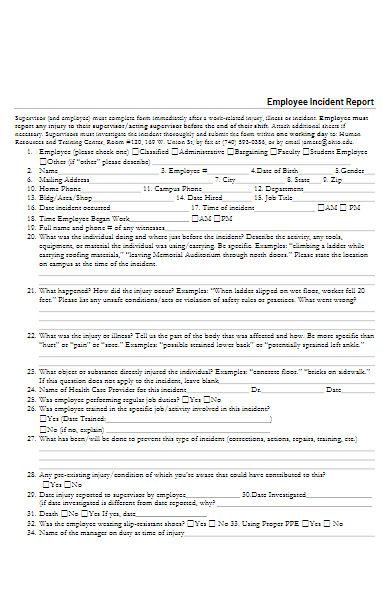
2. Department Employee Incident Report Form
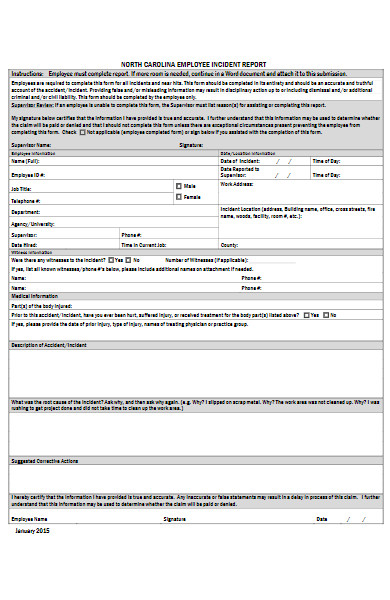
3. Sample Employee Incident Report Form
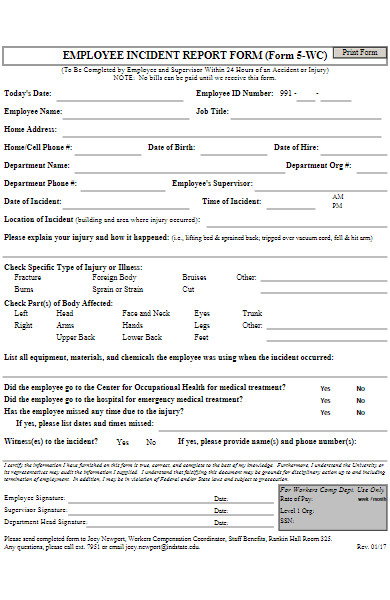
4. Employee Info Incident Report Form
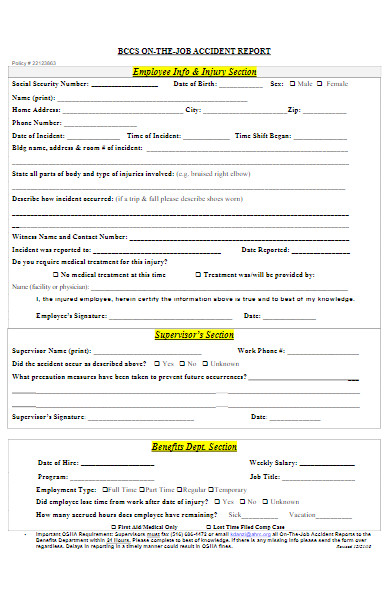
5. Employee Incident Investigation Report Form
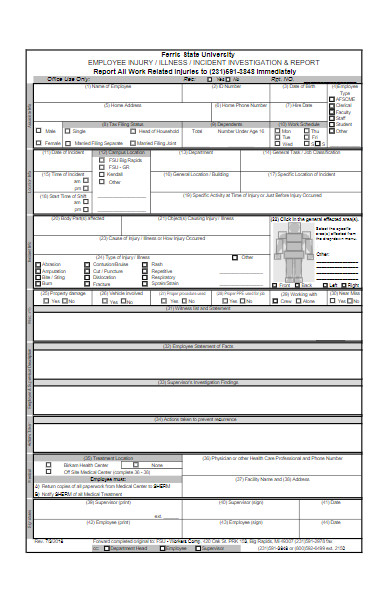
6. Employee Work Incident Report Form
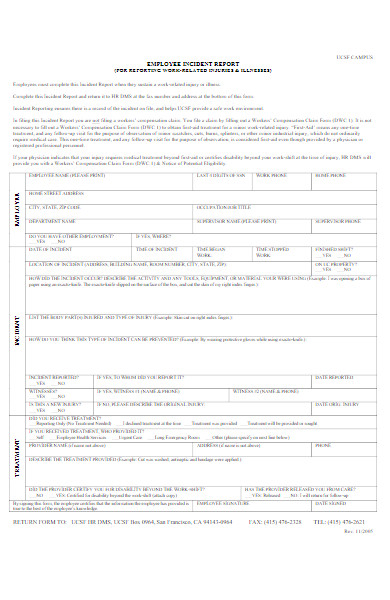
7. Employee Report of Incident Form
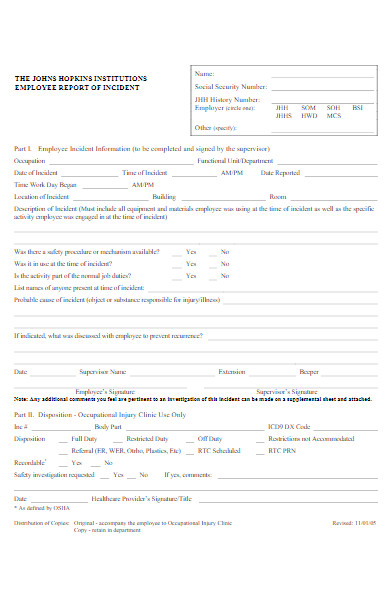
8. Employee First Aid Incident Report Form
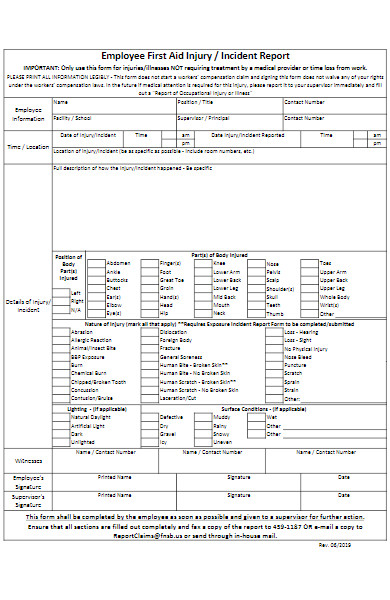
9. Management Employee Incident Report Form
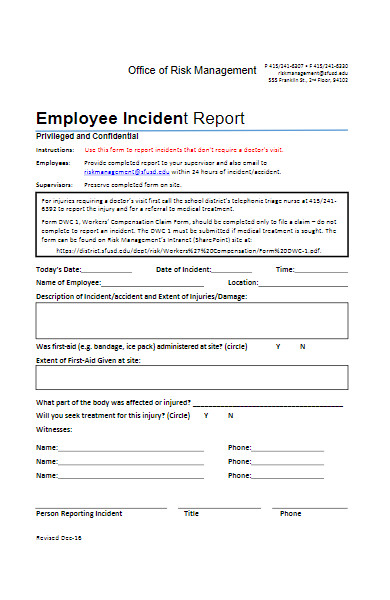
10. Employee Incident Report Form in PDF
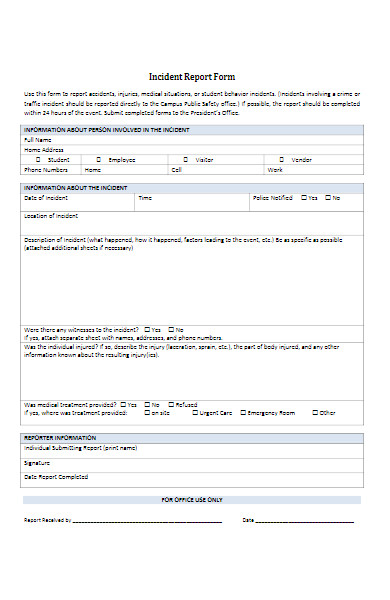
11. Student Employee Incident Report Form
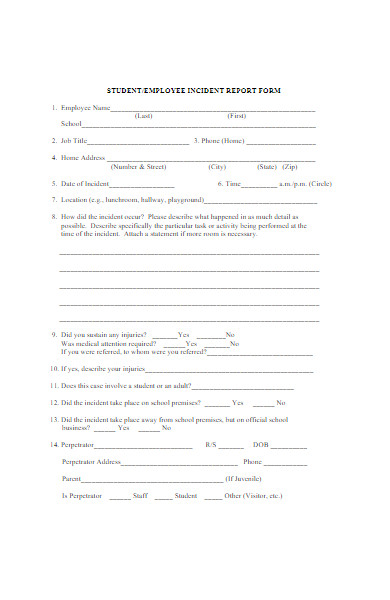
12. Employee Accident or Incident Report Form
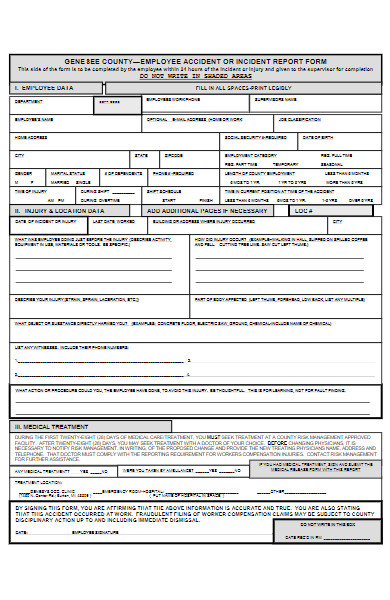
13. Employee Report of Incident and Injury Form
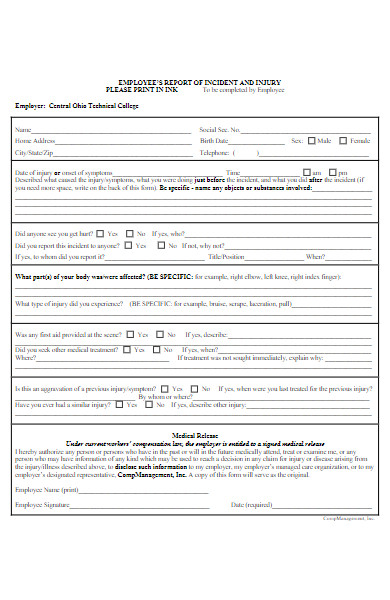
14. Employee Incident and Witness Report Form
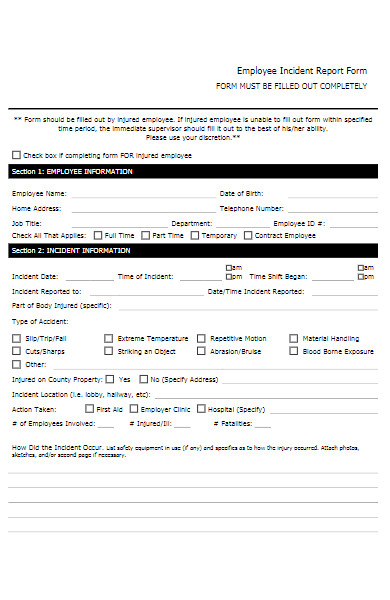
15. University Employee Incident Report Form
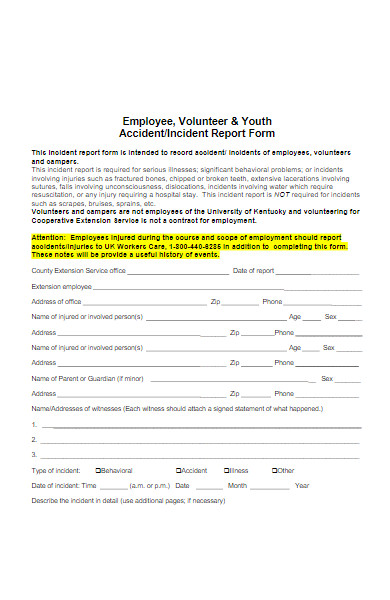
16. Employee Incident Detailed Report Form
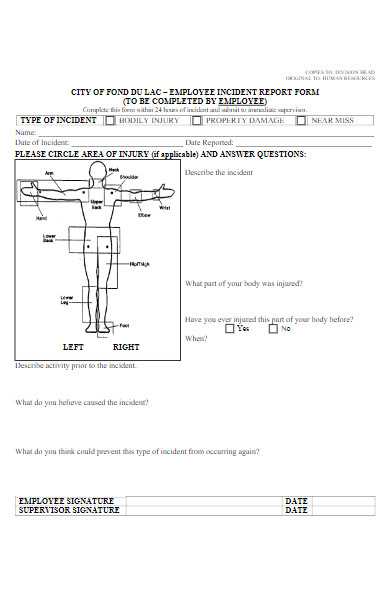
17. Non-Employee Incident Injury Report Form
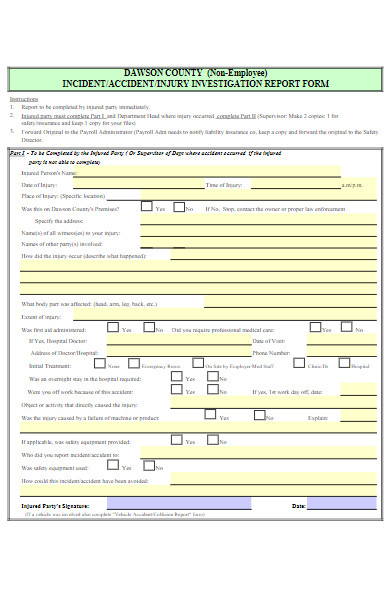
18. Employee Basic Report of Injury Form
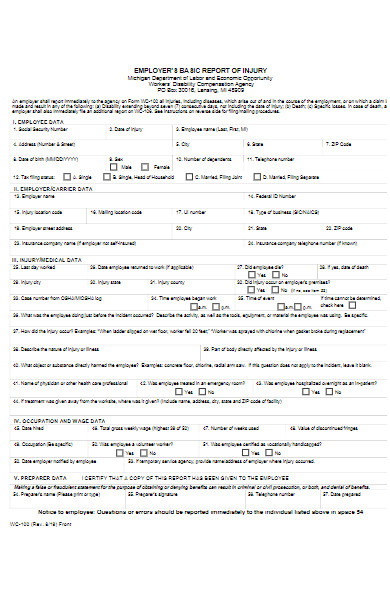
19. Non-Employee Injury Incident Report Form
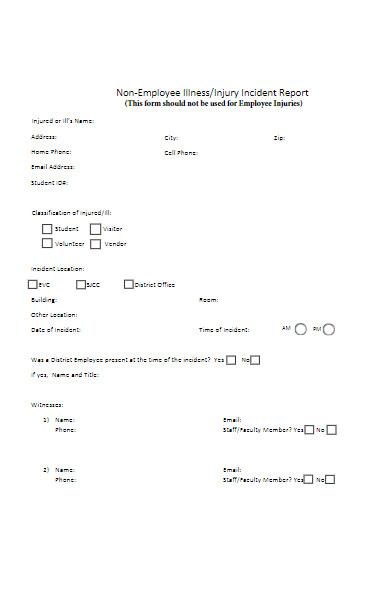
20. HR Employee Incident Report Request Form

21. Employee Incident Report Form for University
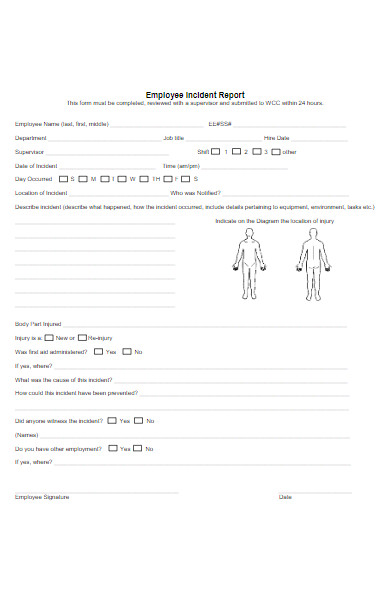
22. School Employee Incident Report Form
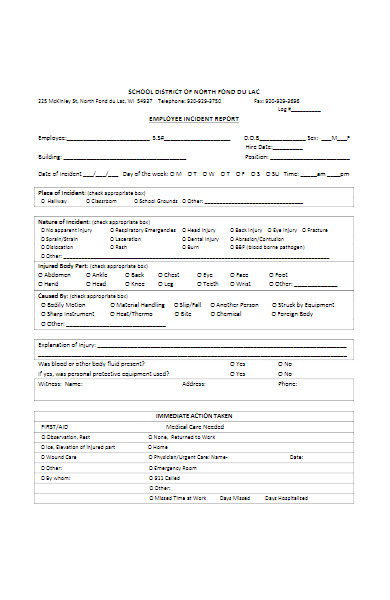
23. HR Employee Incident Report Form
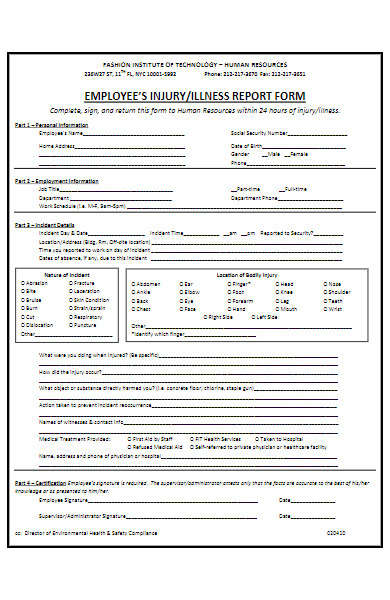
24. Non-Employee Visitor Incident Report Form
25. University Employee Incident Report Form Example
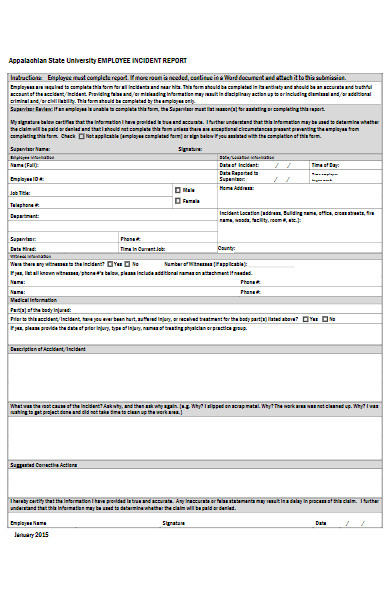
26. Non-Employee Incident Report Form in PDF
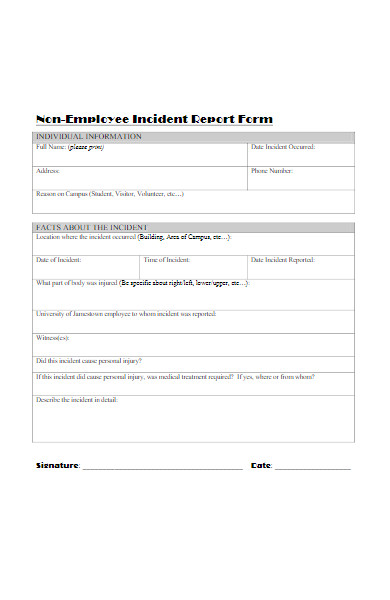
27. Association Employee Incident Report Form
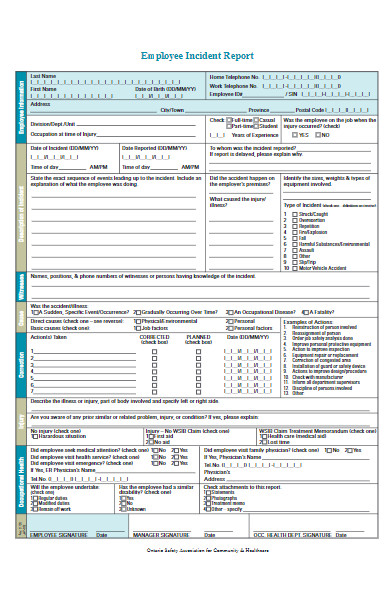
28. College Employee Incident Report Form
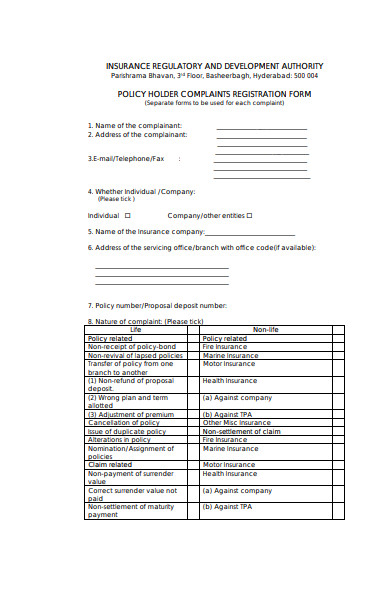
29. Simple Employee Incident Report Form
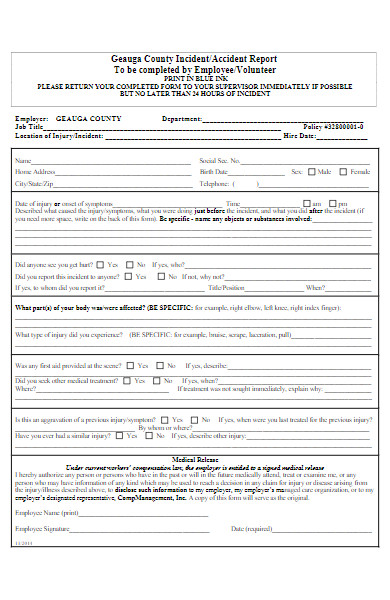
30. Employee Grievance Incident Report Form
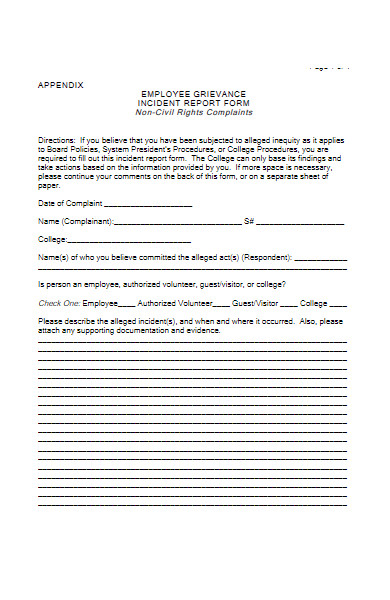
31. Health and Safety Employee Incident Report Form

32. Employee Workplace Violence Incident Report Form
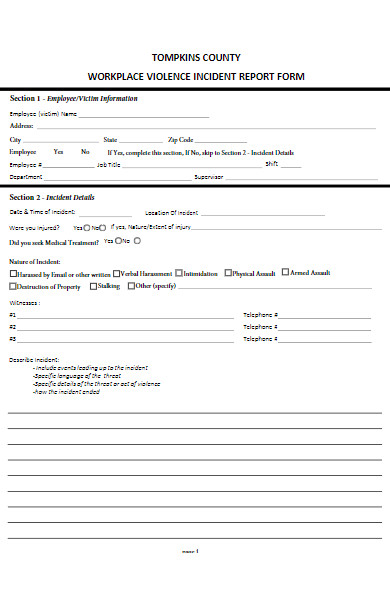
33. Basic Employee Incident Report Form

34. Company Employee Incident Report Form

35. School Employee Accident Incident Report Form
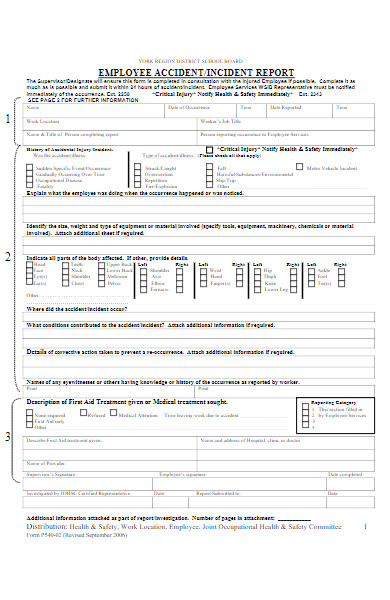
36. Online Employee Incident Report Form
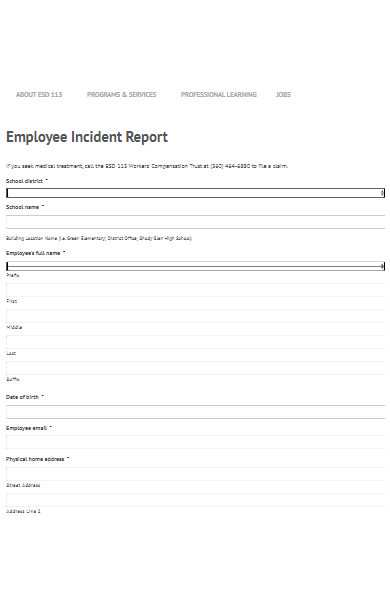
37. Employee Incident Investigation Report Request Form
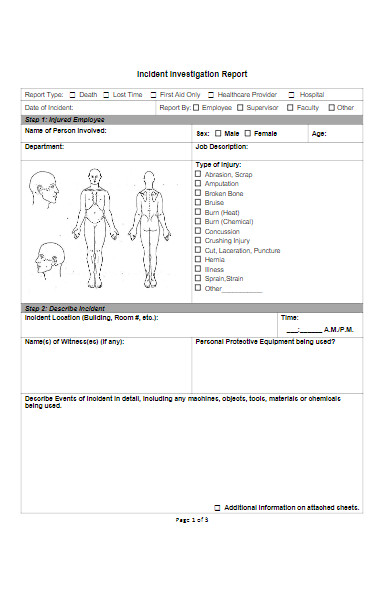
38. Non-Employee Incident Report Form Example
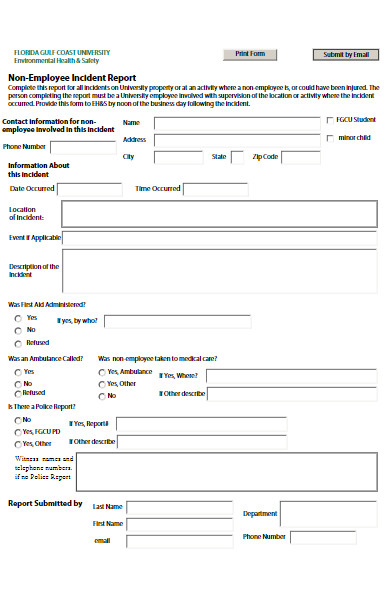
39. University Employee Incident Report Form in PDF
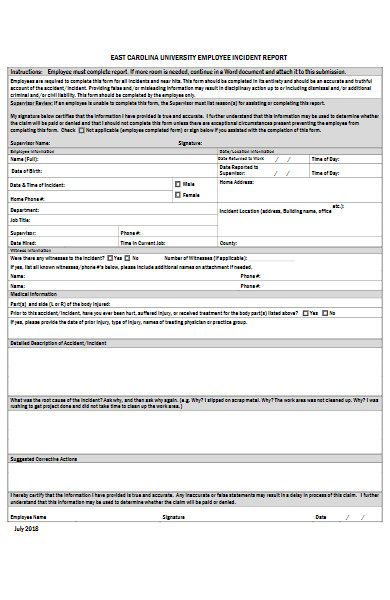
40. Non-Employee Accident or Incident Report Form
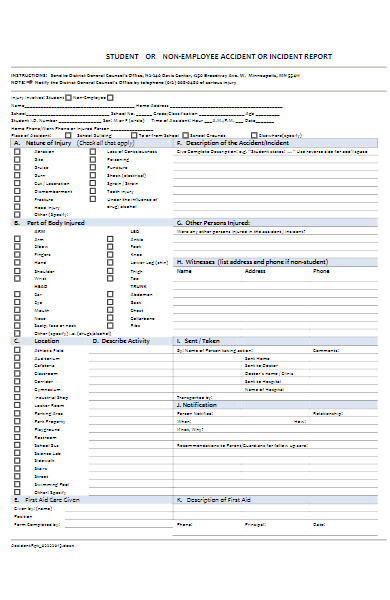
41. Employee Incident Report Form in DOC
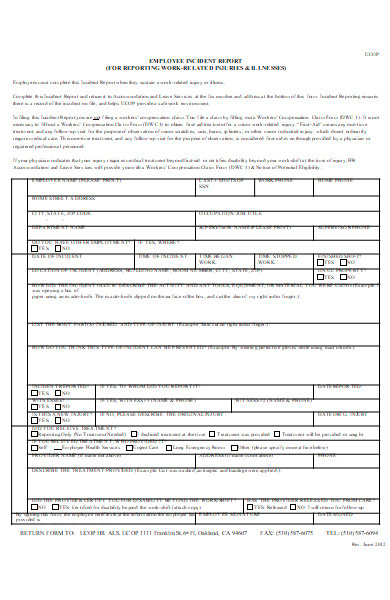
What is the purpose of an Employee Incident Report Form?
The purpose of an Employee Incident Report Form is multifaceted and pivotal for maintaining a safe and accountable workplace environment. Primarily, these fillable form serves to document in detail any unforeseen incidents or accidents that occur within the workspace, involving employees in any capacity. Not only does it ensure a recorded account of the incident from a legal and compliance standpoint, but it also provides a structured mechanism for transparent communication between employees and management regarding untoward events.
Utilization of the Employee Incident Report Form assists in:
- Detailed Documentation: Capturing a comprehensive record of the incident, including particulars about the involved parties, the nature, and the circumstances of the incident.
- Legal and Compliance Adherence: Ensuring that all incidents are reported and recorded in compliance with occupational safety and legal requirements.
- Risk Management: Identifying patterns or repeat occurrences of incidents which might indicate an underlying issue in workplace practices or environments.
- Enhancing Workplace Safety: Utilizing the data to devise and implement preventive strategies and safety protocols to mitigate the recurrence of similar incidents in the future.
- Communication: Facilitating transparent and structured communication between employees, management, and other relevant parties, such as insurance entities.
- Claim Management: Aiding in managing claims related to workplace incidents efficiently, ensuring all pertinent details are available for review and action.
- Investigation: Serving as a foundational document for any subsequent investigations or assessments regarding the incident.
- Employee Protection: Protecting the rights and well-being of employees by ensuring incidents are formally acknowledged and addressed by the organization.
In essence, the Employee Incident Report Form acts as a safeguard, ensuring that incidents are not overlooked, and requisite actions, be it investigational, corrective, or preventive, are initiated, thereby reinforcing a safety-conscious and accountable organizational culture. Our Accident Forms is also worth a look at
When should the Employee Incident Report Form be filled out and submitted?
The Employee Incident Report Form should be filled out and submitted as soon as possible following an incident or accident in the workplace. Timeliness is crucial for several reasons:
- Accurate Recall: Reporting the incident immediately ensures that the details are fresh in the mind of the reporter, leading to more accurate and reliable information being documented.
- Swift Response: Quick reporting allows for a prompt organizational response to the incident, whether it involves providing medical attention, preventing further damage, or initiating an investigation.
- Legal and Compliance Reasons: Some jurisdictions and company policies stipulate a specific timeframe within which incidents must be reported to adhere to legal and compliance standards.
- Risk Mitigation: Immediate reporting facilitates quicker identification and rectification of potential hazards or risks that may have contributed to the incident, thereby preventing possible recurrence or additional incidents.
- Evidence Preservation: In cases where an investigation is necessary, early reporting helps in preserving evidence that may be crucial to understanding the incident’s dynamics and preventing future occurrences.
- Employee Support: Ensuring that any affected employees receive timely support, counseling, or medical attention following the incident.
- Communicative Efficacy: Maintaining transparency and open channels of communication between staff, management, and possibly, external entities like insurance companies or regulatory bodies.
- Claim Processing: In instances where a claim needs to be filed with insurance companies or compensations need to be processed, a timely filed incident report is crucial.
Typically, companies might specify a window, such as 24-48 hours, within which the Employee Incident Report Form should ideally be submitted following an incident. However, it’s crucial to note that reporting should not be delayed for the sake of collecting extensive details or external documents; initial reporting should prioritize primary information and additional details can usually be added as they become available. If unsure about specific company policies or legal stipulations regarding incident reporting timeframes, referring to the employee handbook or consulting with HR is advisable. You can also check our Violent Incident Report Forms.
What information is typically required in an Employee Incident Report Form?
The Employee Incident Report Form is a crucial document that necessitates detailed and accurate information to comprehensively represent the incident, aid any ensuing investigations, and facilitate possible claims processing. Here is a generalized structure, which might slightly vary based on organizational preferences and regulatory requirements:
1. Employee Information
- Full Name: The name of the employee involved.
- Position/Title: Job title of the employee.
- Department: The department where the employee works.
- Date of Hire: When the employee started working at the company.
2. Incident Details
- Date and Time: When the incident occurred.
- Location: The exact location within the workplace where it happened.
- Description: A thorough description of the incident.
3. Witness Information
- Witness Names: Names of any witnesses.
- Contact Details: How to contact them for further information.
4. Injured Party Details (if different from the employee)
- Name: The name of the injured individual.
- Position/Title: Their role or job title.
- Department: The department they are part of.
5. Injury Details
- Nature of Injury: Description of the injury sustained.
- Body Part Affected: Specific body part(s) affected.
- Immediate Action Taken: First aid or other immediate actions.
6. Supervisor/Manager Information
- Name: The name of the supervisor or manager.
- Position: Their job title.
- Contact Information: How to contact them.
7. Incident Investigation
- Root Cause: The identified or presumed root cause of the incident.
- Corrective Actions: Any corrective actions taken or planned.
- Preventative Measures: Steps taken to prevent recurrence.
8. Attachments
- Photographs: Images detailing the incident or injuries.
- Documents: Any other relevant documentation.
9. Declaration
- Signature of the Reporter: Affirmation of the accuracy of the provided information.
- Date: When the form was filled out.
10. Official Use (Management/HR Section)
- Follow-Up Actions: Actions taken by the company post-incident.
- Investigation Findings: Results of any ensuing investigations.
- Notes: Any additional notes relevant to company records.
Each section of the form is designed to capture critical aspects of the incident, ensuring that there is a comprehensive, documented record, which can be referenced for future actions, investigations, or legal and compliance purposes. Always ensure that information is filled out to the best knowledge and ability of the person completing the form, and follow organizational protocols for submission and any necessary follow-up actions. In addition, you should review our Accident Report Form.
How is the information in the Employee Incident Report Form used by the company?
The information provided in an Employee Incident Report Form plays a pivotal role within a company, impacting areas like safety protocols, employee health and wellbeing, legal compliance, and future risk management. Here’s a detailed breakdown of how a company might utilize this information:
1. Ensuring Safety and Implementing Corrective Measures:
- Analyzing the incident to understand its cause and impact.
- Developing and enforcing corrective actions to prevent a recurrence.
2. Supporting the Affected Employee(s):
- Assisting in providing necessary medical care or support.
- Facilitating necessary work accommodations or leave.
3. Legal and Compliance Adherence:
- Maintaining a record to demonstrate compliance with workplace safety laws and regulations.
- Utilizing the information to adhere to reporting obligations under applicable laws.
4. Risk Management:
- Evaluating potential risks or hazards within the workplace.
- Implementing changes to mitigate identified risks.
5. Insurance and Compensation Claims:
- Using the documented information to process insurance claims.
- Ensuring accurate and fair compensation for the affected employee(s).
6. Employee Training and Development:
- Utilizing incident data to develop targeted training programs.
- Enhancing employee awareness and education related to workplace safety.
7. Incident Investigation:
- Conducting a thorough investigation to unearth root causes.
- Implementing findings to enhance organizational safety practices.
8. Policy Development and Review:
- Revising existing policies or developing new ones to enhance safety.
- Regularly reviewing incident reports to keep policies relevant and effective.
9. External Communication:
- Preparing statements or information for external parties (if required) while safeguarding sensitive internal information.
10. Audit and Analysis:
- Performing audits of reported incidents to analyze patterns and trends.
- Using data for periodic safety and risk assessments.
11. Employee Relations:
- Utilizing transparent communication about the incident and follow-up actions to build trust with employees.
- Engaging in dialogues to address any arising concerns or queries post-incident.
12. Regulatory Interactions:
- Engaging with regulatory bodies, providing necessary documentation and insights into the incident and subsequent actions.
13. Enhancing Occupational Health Programs:
- Integrating learnings from incidents to fortify occupational health and wellbeing initiatives.
14. Vendor and Equipment Assessment:
- Reviewing and assessing the reliability of vendors or equipment if they were involved in the incident.
In essence, the information in the Employee Incident Report Form becomes a crucial data point that assists the company in addressing the present incident proficiently and mitigating future risks effectively, all while adhering to legal, compliance, and ethical obligations.
Is the information provided in the Employee Incident Report Form confidential?
Yes, the information provided in the Employee Incident Report Form is typically treated with confidentiality to protect the privacy of the involved parties and to safeguard sensitive company information. However, the degree and nature of this confidentiality can depend on various factors such as organizational policies, legal requirements, and the specifics of the incident.
Here’s a general breakdown of how confidentiality is often handled:
1. Employee Privacy:
- Personal details of the employee(s) involved are usually protected.
- Access to detailed incident information is typically restricted to relevant personnel only.
2. Witness Privacy:
- Details of witnesses are safeguarded to protect them from potential repercussions.
- Their statements are often shared on a need-to-know basis.
3. Legal and Compliance:
- Legal requirements may mandate sharing specific details with regulatory bodies or authorities.
- Compliance with laws might require particular incident details to be disclosed in certain situations.
4. Insurance Processing:
- Pertinent information might be shared with insurance companies for claim processing.
- Care is generally taken to share only the necessary details.
5. Internal Investigations:
- Information is used internally to understand the incident and implement corrective actions.
- Participation in internal investigations often involves access to certain details.
6. External Investigations:
- In certain circumstances, external bodies might investigate incidents, requiring access to relevant information.
7. Employee Communication:
- Depending on the company’s policies, a high-level overview of the incident might be communicated to the staff without disclosing sensitive or personal information.
8. Safety and Prevention Protocols:
- While specific details remain confidential, generalized learnings from the incident might be used to enhance safety and prevention protocols.
9. Record Keeping:
- Documents are securely stored, and access is controlled and logged.
- Record-keeping often adheres to data protection laws and organizational policies.
10. Legal Proceedings:
- In the event of legal actions, certain information may need to be disclosed as part of the legal process.
11. Management Review:
- Some members of the management team will have access to review and analyze incident data.
Confidentiality Obligations:
- Organizations generally have policies outlining the confidentiality obligations concerning Employee Incident Report Forms.
- Employees and other stakeholders are often reminded of the sensitive nature of this information.
Note:
Remember that exact practices may vary between organizations, sectors, and regions, given different legal and regulatory environments. Always refer to specific organizational policies and relevant local laws for precise information regarding confidentiality practices.
Are there different types of Employee Incident Report Forms for various incidents?
Yes, organizations often utilize different types of Employee Incident Report Forms to cater to the varied nature of incidents that can occur within the workplace. The specificity of incident action forms helps in capturing relevant and detailed information suited to the particular type of incident, aiding in subsequent investigations, compliance, and preventative measures.
Common types of Employee Incident Report Forms include:
1. Injury or Accident Report:
- Focuses on detailing any injuries or accidents involving employees.
- Might encompass details about medical assistance provided, nature of injuries, and possible causes.
2. Near Miss Report:
- Records instances where an incident almost occurred, which could have resulted in injury or damage.
- Helps in identifying and mitigating potential future risks.
3. Property Damage Report:
- Documents instances of damage to company property or assets.
- Aids in understanding the cause, extent, and financial implications of the damage.
4. Violence or Harassment Report:
- Captures incidents involving physical violence, harassment, or bullying in the workplace.
- Sensitive information is often particularly safeguarded in these reports.
5. Safety Hazard Report:
- Used to document identified safety hazards that may not have yet resulted in an incident.
- Helps in proactively addressing potential risks.
6. Security Incident Report:
- Focuses on incidents that compromise the physical or digital security of the workplace.
- Might involve data breaches, unauthorized access, or theft.
7. Health and Safety Violation Report:
- Details instances where health and safety protocols have been violated.
- Utilized to manage compliance and educate/train employees.
8. Environmental Incident Report:
- Utilized to document incidents impacting the environment, such as spills or contaminations.
- Often involves detailing remedial actions taken and reporting to regulatory bodies.
9. Vehicle Incident Report:
- For incidents involving company vehicles, detailing damages, injuries, and possibly insurance claims.
10. Customer Incident Report:
- Documents incidents involving customers or clients, such as injuries, complaints, or property damage.
11. Quality Incident Report:
- Focuses on incidents that compromise the quality of products or services.
- Aims to manage and improve operational and manufacturing processes.
12. Productivity Incident Report:
- Captures incidents that significantly disrupt workflow or production schedules.
Different Forms for Different Needs:
- Having specialized forms ensures that pertinent questions and details are not overlooked and that the information gathered is relevant and insightful for each specific type of incident.
- It allows organizations to manage, investigate, and respond to incidents more effectively, safeguarding employees, assets, and the organization at large.
Final Note:
The exact types and specifics of the forms might vary between organizations and sectors due to varied needs, regulatory environments, and organizational structures. Always refer to your specific organizational resources or HR department for precise information.
How can I access the Employee Incident Report Form in my workplace?
Accessing the Employee Incident Report Form at your workplace can typically be achieved through a few standard channels. Here’s a generalized guide:
1. Human Resources Department:
- Direct Contact: Reach out directly to your HR department and ask for the relevant form.
- HR Portal: Check if the HR department has an internal online portal where such forms might be available for download or submission.
2. Intranet or Internal Platforms:
- Document Repository: Some organizations maintain a repository of forms and documents on their intranet or internal platforms.
- Search Feature: Use the search feature on your internal platform to find the form.
3. Immediate Supervisor or Manager:
- Ask your immediate supervisor or manager how to access the form.
- They might provide a physical form or direct you to an electronic version.
4. Company Website:
- Some organizations might provide such forms on their external or internal website for easy access.
5. Safety Officer or Team:
- Safety officers or the safety team in your organization might have access to these forms.
- You might also receive guidance on how to correctly fill out the form.
6. Physical Forms:
- Designated Spots: In some workplaces, physical forms are available at designated spots like the HR department, safety office, or common areas.
- Requesting Copies: You may need to request a copy from a specific department or individual.
7. Employee Handbook or Manual:
- Review your employee handbook or manual, which might guide you on how to access various forms and documents.
8. Helpdesk or IT Support:
- If your company has an IT helpdesk or support team, they might assist in navigating to the digital form on your intranet or online portal.
9. Peer Assistance:
- Colleagues might guide you on how they’ve accessed and utilized the form in the past.
10. Email Communications:
- Check your email for any past communications that might include attachments or links to the incident report form.
- You may also email HR or other relevant departments requesting the form.
Note on Best Practices:
- Ensure to maintain confidentiality and follow proper channels, especially if the incident is sensitive in nature.
- It’s beneficial to familiarize yourself with the process and know where to access such forms even before any incident occurs.
- Utilize proper channels for submission as guided by your company policies and ensure timely reporting.
Reminder:
Procedures can vary significantly between organizations. Always refer to your specific organizational guidelines or contact relevant departments for accurate instructions relevant to your workplace.
Is there a follow-up procedure after the Employee Incident Report Form is submitted?
Yes, generally, after an Employee Incident Report Form is submitted, there is a follow-up procedure to ensure that the incident is investigated, appropriate actions are taken, and future incidents of a similar nature are prevented. While specific procedures might vary from one organization to another, a general follow-up procedure might look something like this:
1. Acknowledgement of Receipt:
- Employees who submitted the report typically receive an acknowledgement that their form has been received.
2. Review and Initial Assessment:
- Relevant personnel (like HR, Safety Officers, or Management) review the incident report.
- An initial assessment to determine the severity and immediate actions required for the incident is conducted.
3. Investigation of the Incident:
- A thorough investigation to understand the root cause of the incident is usually performed.
- This may involve speaking to the employee(s) involved, witnesses, and analyzing any available data or evidence.
4. Implementing Immediate Actions:
- If the incident demands, immediate corrective actions (like medical care, repair, or safety measures) are implemented.
5. Communication:
- Depending on the organization and the incident, relevant stakeholders (such as affected employees, departments, or teams) might be informed about the incident and the actions being taken.
6. Detailed Analysis:
- A detailed analysis of the incident, including why it happened and the consequences, is often carried out.
- This could involve understanding if it was a one-off incident or if there is a risk of it recurring.
7. Developing a Corrective Action Plan:
- Based on the investigation and analysis, a corrective action plan is developed to address the issue and prevent recurrence.
- This could involve changes in policies, procedures, training, or physical changes in the workplace.
8. Implementation of Corrective Actions:
- The developed action plan is then implemented.
- This might involve physical changes, training sessions, policy updates, or other relevant interventions.
9. Follow-Up Evaluation:
- The effectiveness of the corrective actions is monitored and evaluated over a set period.
10. Documentation and Record Keeping:
- All actions, findings, and steps taken post-incident are documented and stored securely for future reference and compliance.
11. Feedback to Reporting Employee:
- Feedback, when appropriate and without breaching confidentiality, is often provided to the employee who reported the incident.
- They might be informed about the actions taken without revealing sensitive or confidential information.
12. Review and Continuous Improvement:
- Periodically, organizations review the incidents and the effectiveness of the corrective actions to understand trends and improve further.
Additional Notes:
- Confidentiality: Throughout this process, it’s crucial that confidentiality and privacy are maintained.
- Legal and Compliance: In certain incidents, legal counsel might be involved and regulatory bodies informed as per legal and compliance obligations.
Always refer to your specific organizational guidelines or policy manual to understand the exact follow-up procedure followed in your workplace.
How to Create an Employee Incident Report Form? – a Step by Step Guide
Creating an Employee Incident Report Form requires a thoughtful approach to ensure that all relevant information is captured and that it is user-friendly for employees. Here’s a step-by-step guide to creating this vital document:
Step 1: Define the Purpose
- Understand the Necessity: Identify and articulate the need and purpose of the form.
- Compliance and Legalities: Ensure that the form is in compliance with legal and industry standards.
Step 2: Gather Basic Information
- Employee Details: Include fields for the employee’s name, department, position, and contact details.
- Date and Time: Ensure a field for the date and time of the incident.
- Location: Include a section for specifying the exact location where the incident took place.
Step 3: Incident Details
- Description: Provide a spacious field where employees can write a detailed description of the incident.
- Witnesses: Include fields for the names and contact details of any witnesses.
- Immediate Actions Taken: Add a section to describe any immediate actions taken post-incident.
Step 4: Injury/ Damage Details
- Nature of Injury/Damage: Include fields to describe the type and extent of any injuries or damages.
- Medical Attention: A section that outlines any medical attention received or required.
Step 5: Photo or Document Attachments
- Attachment Option: Include a feature or section where employees can attach photos or documents relevant to the incident.
Step 6: Privacy and Confidentiality Assurance
- Confidentiality Clause: Add a note about how the information will be stored and used, ensuring confidentiality.
- Data Protection: Ensure the form adheres to data protection regulations like GDPR.
Step 7: Include an Acknowledgement Section
- Verification: A section for employees to verify that the provided information is accurate and truthful.
- Signature and Date: Include fields for a signature and date to validate the report.
Step 8: Form Design and Accessibility
- User-Friendly Design: Ensure the form is designed in a clear, accessible, and easy-to-read manner.
- Availability: Make the form easily accessible, both digitally and in a physical format if needed.
Step 9: Review and Feedback
- Peer Review: Have the form reviewed by peers, preferably from varied departments.
- Feedback Loop: Allow for modifications based on feedback from a test group of employees.
Step 10: Implementation and Communication
- Communication: Inform staff regarding the new form and its availability.
- Training: Conduct brief training or information sessions to guide staff on how and when to use the form.
Step 11: Regular Updates and Revisions
- Periodic Review: Regularly review the form for any necessary updates or improvements.
- Legal Compliance: Ensure ongoing compliance with any updated legal or industry standards.
Step 12: Digitalization (Optional)
- Online Submission: If possible, create a digital version of the form for online submission.
- Database Integration: Ensure that the form can be integrated into your existing HR or Incident Management System.
Additional Note:
Always consider legal counsel or a specialist to review the form, ensuring that it is in compliance with all relevant laws and regulations. Additionally, adapt the form based on ongoing needs and feedback form to ensure it remains an effective tool for incident reporting within your organization.
Tips for creating an Effective Employee Incident Report
Creating an effective Employee Incident Report involves combining clarity, comprehensiveness, and user-friendliness to ensure accurate incident recording and facilitate subsequent actions. Here are some tips to consider:
1. Clarity is Key:
- Simplicity: Use clear and simple language to ensure understanding across various literacy levels among employees.
- Instructions: Provide concise instructions on how to fill out the form accurately.
2. Accessibility Matters:
- Multiple Formats: Make available in various formats (digital, print, etc.) to cater to diverse needs.
- Visibility: Ensure the form is easy to find and access by all employees.
3. Focus on Confidentiality:
- Privacy Assurance: Clearly mention how the data will be stored, used, and protected.
- Anonymous Reporting: Consider incorporating an anonymous reporting option if appropriate.
4. Ensure Legal Compliance:
- Legal Review: Have the form reviewed by legal experts to ensure compliance with laws and regulations.
- Regular Updates: Periodically revise the form to adhere to any changes in laws and internal policies.
5. Specify Details Needed:
- Explicit Fields: Clearly define what each field on the form represents and the type of information needed.
- Examples: Provide examples for complex sections to guide employees on what information is required.
6. User-Friendly Design:
- Logical Flow: Arrange the sections in a logical sequence that mirrors the way incidents are usually described.
- Aesthetic Appeal: Ensure the form is visually appealing and easy to navigate.
7. Incident Categorization:
- Types of Incidents: Provide categories or checkboxes to specify the type of incident being reported.
- Customized Sections: Have particular sections that are relevant to specific types of incidents.
8. Include All Relevant Sections:
- Witness Details: Create a section to capture details of any witnesses.
- Action Taken: Include a section for any immediate actions taken post-incident.
9. Provide Guidance and Support:
- Help Information: Add contact details for personnel to assist if employees need help filling out the form.
- Follow-Up Process: Outline the steps that will be taken once the form is submitted.
10. Feedback Mechanism:
- Feedback Option: Include a section for employees to provide feedback on the incident reporting process and form.
- Continuous Improvement: Use feedback to continually refine and improve the form and process.
11. Facilitate Documentation:
- Attachment Section: Include an option to attach photos, documents, or additional information relevant to the incident.
- Additional Notes: Provide space for any additional notes or comments.
12. Implement Training Sessions:
- Training: Educate employees on the importance, usage, and access of the incident report form.
- Scenarios: Use scenarios to illustrate how and when to use the form.
13. Ensure Robust Follow-Up:
- Response Time: Define and communicate the expected time frame for an initial response to the report.
- Outcome Communication: Develop a mechanism to communicate the outcomes of the incident investigation where applicable.
14. Technology Integration:
- Digitalization: Enable digital submissions, and if possible, integrate with incident management systems.
- Data Management: Ensure robust data management to facilitate analyses of incident trends.
15. Pilot and Review:
- Pilot Testing: Conduct pilot testing with a small group to garner feedback before a full-scale rollout.
- Regular Review: Periodically assess and revise the form based on evolving organizational needs and feedback.
By implementing these tips, you can develop an Employee Incident Report that not only captures necessary details efficiently but also ensures user engagement, accuracy, and legal compliance.
The Employee Incident Report Form, crucial in managing workplace incidents, ensures systematic documentation of undesired events, fostering a transparent, accountable work environment. Understanding its multifaceted meanings, exploring varied types, and learning through real-world examples enhances our insight into its necessity. Knowledge about creating this vital form, aided by our step-by-step guide, optimizes organizational functionality, solidifying an inclusive, fair, and secure professional space for all stakeholders involved. You may also be interested in our Joining Report Form.
Related Posts
FREE 45+ Work From Home Forms in PDF | MS Word
FREE 15+ Overtime Authorization Forms in Excel | PDF | MS Word
FREE 50+ Supervisor Evaluation Forms Download – How to Create Guide, Tips
FREE 8+ Reclassification Request Forms in PDF | MS Word | Excel
FREE 15+ Job Description Forms in PDF | MS Word
FREE 11+ Change of Address Forms in PDF | MS Word | Excel
FREE 10+ Employee of the Month Nomination Forms in PDF | MS Word
FREE 14+ Employee Appraisal Forms in PDF | Excel | MS Word
FREE 10+ Sample Employee Clearance Forms in PDF | MS Word | Excel
FREE 8+ Sample Employee Warning Notice Forms in PDF | Word | Excel
FREE 11+ Employee Absence Forms in PDF | MS Word | Excel
FREE 40+ HR Forms in PDF
FREE 50+ Return to Work Forms in PDF | MS Word
FREE 14+ Employee Suggestion Forms in MS Word | Excel | PDF
FREE 14+ Employee Witness Statement Forms in MS Word | PDF
